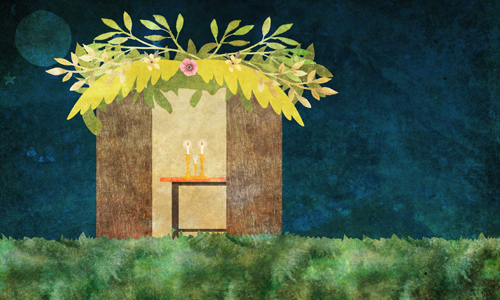13 Facts About Sukkot Every Jew Should Know
1. Sukkot Starts on a Full Moon
2. Sukkot Is the Holiday of Shelters
Sukkot is Hebrew for “booths” or “shelters.” As the verse states, “Your [ensuing] generations should know that I had the children of Israel live in shelters when I took them out of the land of Egypt.”1
What were these shelters? The Talmud tells us that they were the clouds of glory that encompassed the entire nation during their epic 40-year trek through the Sinai desert.
3. Sukkot Has Three Other Names
Sukkot is a joyous holiday—so joyous that the sages called it simply Chag, Hebrew for “Festival.”
In our liturgy, we call it Zeman Simchatenu, “The Time of Our Rejoicing.”
4. The Sukkah Booth Is Covered With Organic Material
For the duration of Sukkot, the sukkah—a structure covered with greenery, bamboo, or something else that has been harvested from the ground—becomes our home. The covering is known as sechach. Kosher sechach must have grown from the ground and been harvested. It cannot be the overhang of a nearby tree, for example. Common sechach choices include evergreen branches, cornstalks, palm fronds, bamboo, or specially produced mats.
5. The Sukkah Becomes Our Second Home on Sukkot
We eat all meals, study, and schmooze (and even sleep) in the sukkah, where only the flimsy sechach separates us from the wide, open sky.
A sukkah can be erected just about anywhere, provided it’s under the sky. The Talmud talks about ox-cart sukkahs, boat sukkahs, treetop sukkahs and camelback sukkahs.3Nowadays there are are sukkah mobiles (on pickup trucks) and even pedi-sukkahs.
6. The Lulav and Etrog Are Taken (Almost) Every Day of Sukkot
Every day of Sukkot (besides for Shabbat) we take a bundle of greens—made of a lulav (palm frond), three hadasim (myrtles), and two aravot (willows)—along with an etrog (citron). We hold them together, bless G?d who “sanctified us with His commandments and commanded concerning the taking of the lulav,” and wave them gently in six directions. This is often referred to as the “lulav and etrog” or the arba minim, “four kinds.”
The four kinds are also held and waved during Hallel (“Psalms of Praise” said as part of the holiday morning service), as well as during the Hoshaanot, a daily Sukkot ceremony that involves circling a Torah scroll while chanting prayers for salvation.
7. There Are Special Blessings to Be Said
The first time you do each mitzvah you make another blessing, Shehecheyanu, which blesses G?d, Who has “given us life, sustained us, and brought us to this time.”
8. The Last Day is Hoshana Rabbah
On the seventh day of Sukkot, the bimah (platform in middle of the synagogue) is circled seven times, instead of the one circuit done every day of the holiday thus far. Since the Hoshaanot are repeated again and again, this day is known as Hoshana Rabbah (“The Great Hoshana”). At the end of this once-a-year service, each person beats a bundle of five willows (also known as hoshaanot) against the ground.
On this day, it is customary to have a festive meal in the sukkah that includes challah dipped in honey (the last time for the season) and kreplach, dumplings stuffed with meat.
9. Sukkot Was a Pilgrimage Festival
10. The Joyous Water Drawing Was on Sukkot
Priests kindled fires on great lamps, lighting up Jerusalem as if it were the middle of the day. Throughout the night, pious men danced holding torches, scholars juggled, and Levites played music, while the lay people watched with excitement.
Nowadays, many communities hold celebrations on the nights of Sukkot in commemoration of the water-drawing ceremony. The Rebbe encouraged that the dancing spill out into the streets.
11. Spiritual Guests Visit Every Day of Sukkot
Some people recite a special text, in which they formally “invite” the ushpizin into their sukkahs.
12. Not All the Days Are the Same
The remaining days of Sukkot are known as chol hamoed, during which travel and other melachot (forbidden acts) are permitted (but strenuous work should be avoided if possible).
13. Sukkot Is Followed by Another Holiday
Immediately after the seven days of Sukkot, we step into Shemini Atzeret and Simchat Torah. In the Diaspora, this holiday extends for two days; in Israel, it is confined to a single day. Simchat Torah fetes the completion of the annual Torah-reading cycle and the start of the new cycle. It is marked with vigorous singing and dancing in the synagogue. This is the only instance of one Jewish holiday coming directly after another one.
Source: Chabad.org
